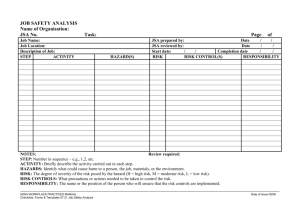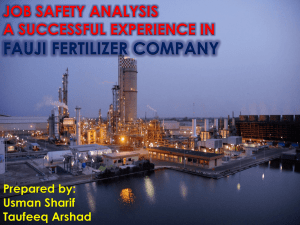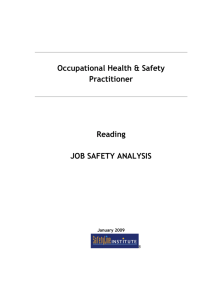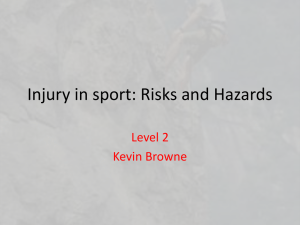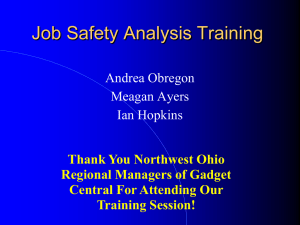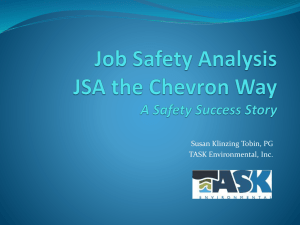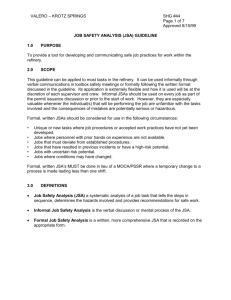JSA Training PowerPoint Presentation
advertisement
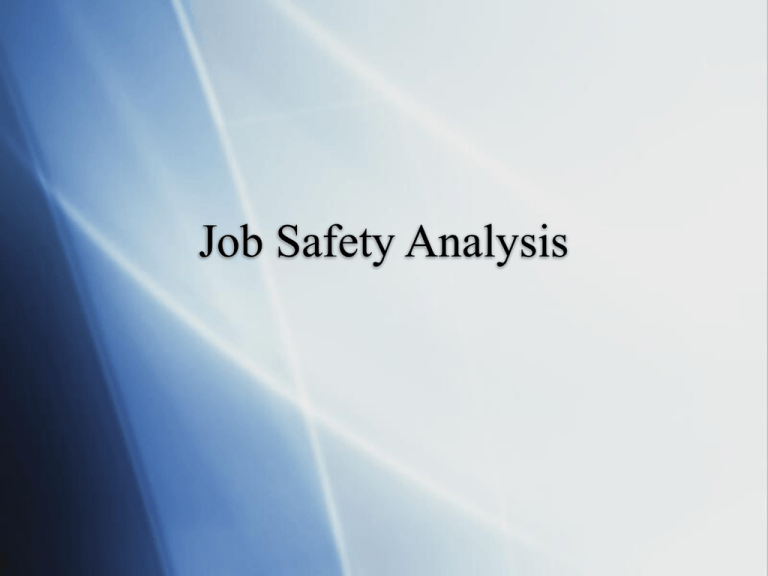
Job Safety Analysis Housekeeping • Agenda/Time • Cellular Phones • Emergency Exits • Smoking • Stretch Breaks/Lunch/Refreshments • Washrooms About This Program • Defining Job Safety Analysis • Roles and Responsibilities • Job Safety Analysis – Preparation – Observation & Analysis – Hazard identification – Follow up • Benefits of JSA Definitions Job Safety Analysis (JSA) is a technique to identify the health and safety hazards of specific tasks in order to reduce the risk of injury to workers. Job Task Analysis (JTA) is a tool used to assist with an effective return-to-work program. It Definitions –Procedure – step by step instructions on how to perform a specific task, usually for critical tasks. –Practice – general guidelines (do’s and don’ts) for performing a specific task, usually a low risk task that is Job Safety Analysis • Is a Proactive Risk Management process, which includes: – Identifying all health and safety hazards – Evaluating the risk in each hazards – Controls for eliminating or reducing the risk in each hazard Job Safety Analysis Assists In : • identifying hazards • development or improvement of practices and procedures • incident investigations • improvement of workers training, preventative maintenance lists… • identification immunization and infection control issues • improved communication Defining JTA • Method to document demands of assigned tasks. • Detailed- includes amount of time required to perform each task. • Compares the demands of the task to the abilities of the worker- benefiting workers on return-to-work programs. Responsibilities Outlined: • Management • Supervisor • Worker • Occupational Health and Safety Committee • Regional Safety Coordinator Management • Review and/or approve new policies / procedures that are made • Ensure that: – there are assigned task force / job safety analysis teams – control systems are initiated and maintained, that are necessary to protect workers from exposure to hazardous conditions. – approved recommendations made are implemented. Supervisor • Assign members to the JSA team • Coordinate and assist in the identification of hazards • Actively participate in the JSA process • Implement approved recommendations made as a result of the JSA • Initiate and maintain control systems • Ensure the need for new policies/procedures are identified and Worker • Participate and cooperate with others in the identification of hazards in the workplace • Comply with the changes made as a result of the job safety analysis recommendations • Inform supervisors of changes in the workplace that affect existing workplace Occupational Health Committees • Assist in the identification of hazards, assessment of risk and control measures taken • Provide input and advice throughout the process • Review all Job Safety Analysis, policies and procedures to make sure they stay relevant and current with conditions, workers, equipment etc. • Do follow-up evaluation of the Regional/Agency Safety Coordinator • Act as a resource during the assessments • Coordinate with Management, Supervisors and the Occupational Health Committees, to have or assist with or undertake a job safety analysis • Use the job safety analysis as the basis for establishing workplace policy, procedures, practices and other components of the Occupational Health and Safety Program • Ensures communication Regional Strategy • Regions can divide up job descriptions throughout region • Regions can focus on a specific job description and divide up the tasks that are associated with that job description throughout the region • General JSA can be distributed to all regional agencies and then made agency specific • General JSAs which apply to a number of Involve employees by: • Explaining why JSA is necessary and that their expertise is crucial to a strong JSA program. • Explaining that the team is studying the task not worker performance Involve the employees by: –Making them part of the observation team –Referring the JSA back to them after each analysis step –Conferring with them when JSA is complete Job Safety Analysis Step 1: –Preparation –Observation & Analysis –Hazard identification –Control identification –Follow up Preparation • Make a list of all job descriptions • Make an initial task list from the job descriptions – Example: • Lab Technologist – Sample collection » Ward, ER, Outpatients – Sample analysis – Waste disposal – Equipment maintenance Pay particular attention to: • • • • • High risk job descriptions or tasks Complex procedures Rarely performed tasks New tasks Recently modified tasks Preparation: Priority • We determine priority by doing a risk assessment on each task within the description by considering three key factors. – Severity – Frequency – Probability Severity… • What will most likely happen if something goes wrong? – Scale of 1-3 Frequency • How often will a worker come in contact with the hazard? • Scale of 1-3 Probability… • What is the likelihood that something will go wrong during the task? • Scale of 1-3 To determine the S-F-P values • Review incident reports • Review WCB statistics • Review Sask. Labour Reports incl. contraventions • Review maintenance logs • Speak with employees who perform the task Risk Assessment & JSA Priority • Add up the severity, frequency, probability ratings to determine the highest ranking job descriptions. • From those targeted descriptions compare the task ratings within the description. • The JSA team and those involved set the plan for the region, agency and team as to which job descriptions and task should be targeted first. Job Safety Analysis Step 2: –Preparation –Observation and Analysis –Hazard identification –Control identification –Follow up Observation Team • Is often the area supervisor and may include other workers and members of the local OHC • A more rounded group of observers ensures that key points are not being missed Pre-Observation Team should: • • • • review JSA procedures review legislation related to the job review best practices if applicable ensure they are trained and supplied with all PPE needed to observe the tasks safely Employee to be observed: Should be: –experienced in their job –safety conscious –capable of doing all steps in task –encouraged to explain what is being done –encouraged to ask questions of the observation team Analysis • Observe task under normal working conditions • Breakdown the task into steps as it is being observed • Make sure to record the steps in order • Decrease observations to 10 steps or less whenever possible. • Use action words to describe steps Recommendations • Be sure not to make the steps too general or too detailed. • Make sure steps reflect what is being done NOT how it is being done. • Ask questions??? • Have other participants review the basic steps before hazard identification JSA Example: Adult CPR Sequence of Job Task Check scene safety Don PPE Check for consciousness Open airway, check breathing Potential Health and Safety Hazard Controls and Resources Job Safety Analysis Step 3: –Preparation –Observation & Analysis –Hazard Identification –Control Identification –Follow up Hazard Identification • Identify hazards relating to each step • Consider all potential hazards during: – Normal situations – Unexpected events – Job modification situations • Refer to legislation, best practice, expert opinion to assist JSA Example: Adult CPR Sequence of Job Task Potential Health and Safety Hazard Check scene safety Vehicular traffic, bystanders, hidden dangers, weather Don PPE Communicable disease Inadequate or no PPE, Inadequate training. Check for consciousness Combative patient Open airway, check breathing Controls and Resources Job Safety Analysis Step 4: –Preparation –Observation & Analysis –Hazard Identification –Control Identification –Follow up Control Identification • Eliminate the hazard • Reduce the hazard • Control the hazard Hazard Controls and Resources • Observation team must now identify strategies to protect employees from the hazards noted. • Can they: – Find a new way to do the task – Change the conditions that create the hazard – Change the work procedure – Change the time, location etc. that the task is done Process for Identification • Engineering • Administration • Personal protective equipment JSA Example: Adult CPR Sequence of Job Task Potential Health and Safety Hazard Controls and Resources Check scene safety Vehicular traffic EMS vehicle training, reflective jackets. Procedure review by-standers, hidden dangers, weather Don PPE Communicable disease inadequate or no PPE, Inadequate training. Check for consciousness Open airway, check Combative patient Updates from HC, local medical officer. Updated PPE training. Final Details • Have all parties review and comment on JSA before it is distributed • Communicate the finalized information and for feedback • Date the JSA for future reference during reviews and updates Communication • To all employees at all levels affected by analysis • Orientation • Job updates • General and Safety meetings • Occupational Health Committee Meetings Job Safety Analysis Step 5: –Preparation –Observation & Analysis –Hazard Identification –Control Identification –Follow up Review and follow up • Periodically • When tasks change • When concerns are identified by the Workplace Responsibility System Evaluate Implemented Controls • It is important to remember that implemented controls may not work as effectively and efficiently as first thought. • Re-evaluation of all enacted controls, procedures etc. should be done regularly throughout the first year after one month, and every three months after that by area supervisors and staff. Recap of JSA Benefits • Can be used to update procedures and practices • Used to refine training at all levels • Used to identify deficiencies in the agencies safety management system • JSA can be used during incident investigation • JSA can be used to refine inspection lists • Can be used to assist with Job Task
